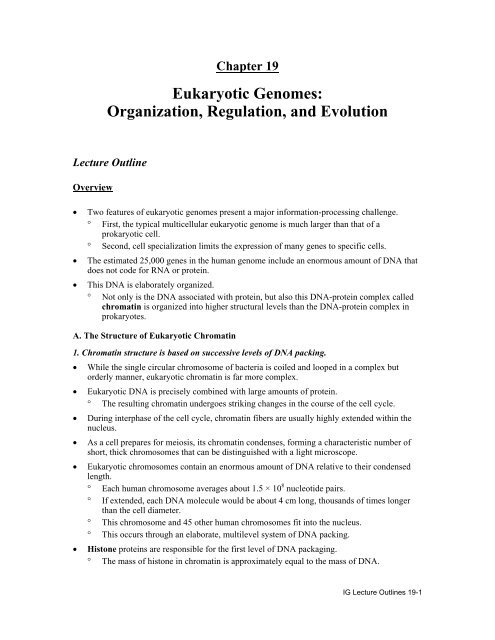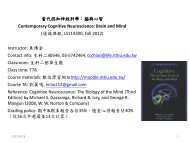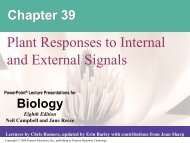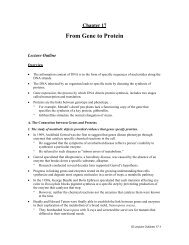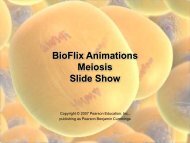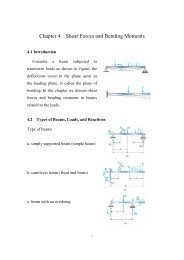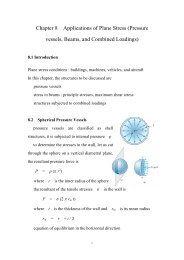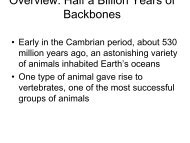chapter 19 the organization and control of eukaryotic genomes
chapter 19 the organization and control of eukaryotic genomes
chapter 19 the organization and control of eukaryotic genomes
Create successful ePaper yourself
Turn your PDF publications into a flip-book with our unique Google optimized e-Paper software.
Chapter <strong>19</strong>Eukaryotic Genomes:Organization, Regulation, <strong>and</strong> EvolutionLecture OutlineOverview• Two features <strong>of</strong> <strong>eukaryotic</strong> <strong>genomes</strong> present a major information-processing challenge.° First, <strong>the</strong> typical multicellular <strong>eukaryotic</strong> genome is much larger than that <strong>of</strong> aprokaryotic cell.° Second, cell specialization limits <strong>the</strong> expression <strong>of</strong> many genes to specific cells.• The estimated 25,000 genes in <strong>the</strong> human genome include an enormous amount <strong>of</strong> DNA thatdoes not code for RNA or protein.• This DNA is elaborately organized.° Not only is <strong>the</strong> DNA associated with protein, but also this DNA-protein complex calledchromatin is organized into higher structural levels than <strong>the</strong> DNA-protein complex inprokaryotes.A. The Structure <strong>of</strong> Eukaryotic Chromatin1. Chromatin structure is based on successive levels <strong>of</strong> DNA packing.• While <strong>the</strong> single circular chromosome <strong>of</strong> bacteria is coiled <strong>and</strong> looped in a complex butorderly manner, <strong>eukaryotic</strong> chromatin is far more complex.• Eukaryotic DNA is precisely combined with large amounts <strong>of</strong> protein.° The resulting chromatin undergoes striking changes in <strong>the</strong> course <strong>of</strong> <strong>the</strong> cell cycle.• During interphase <strong>of</strong> <strong>the</strong> cell cycle, chromatin fibers are usually highly extended within <strong>the</strong>nucleus.• As a cell prepares for meiosis, its chromatin condenses, forming a characteristic number <strong>of</strong>short, thick chromosomes that can be distinguished with a light microscope.• Eukaryotic chromosomes contain an enormous amount <strong>of</strong> DNA relative to <strong>the</strong>ir condensedlength.° Each human chromosome averages about 1.5 × 10 8 nucleotide pairs.° If extended, each DNA molecule would be about 4 cm long, thous<strong>and</strong>s <strong>of</strong> times longerthan <strong>the</strong> cell diameter.° This chromosome <strong>and</strong> 45 o<strong>the</strong>r human chromosomes fit into <strong>the</strong> nucleus.° This occurs through an elaborate, multilevel system <strong>of</strong> DNA packing.• Histone proteins are responsible for <strong>the</strong> first level <strong>of</strong> DNA packaging.° The mass <strong>of</strong> histone in chromatin is approximately equal to <strong>the</strong> mass <strong>of</strong> DNA.IG Lecture Outlines <strong>19</strong>-1
° Their positively charged amino acids bind tightly to negatively charged DNA.° The five types <strong>of</strong> histones are very similar from one eukaryote to ano<strong>the</strong>r, <strong>and</strong> similarproteins are found in prokaryotes.° The conservation <strong>of</strong> histone genes during evolution reflects <strong>the</strong>ir pivotal role inorganizing DNA within cells.• Unfolded chromatin has <strong>the</strong> appearance <strong>of</strong> beads on a string.° In this configuration, a chromatin fiber is 10 nm in diameter (<strong>the</strong> 10-nm fiber).• Each bead <strong>of</strong> chromatin is a nucleosome, <strong>the</strong> basic unit <strong>of</strong> DNA packing.° The “string” between <strong>the</strong> beads is called linker DNA.• A nucleosome consists <strong>of</strong> DNA wound around a protein core composed <strong>of</strong> two moleculeseach <strong>of</strong> four types <strong>of</strong> histone: H2A, H2B, H3, <strong>and</strong> H4.° The amino acid (N-terminus) <strong>of</strong> each histone protein (<strong>the</strong> histone tail) extends outwardfrom <strong>the</strong> nucleosome.° A molecule <strong>of</strong> a fifth histone, H1, attaches to <strong>the</strong> DNA near <strong>the</strong> nucleosome.• The beaded string seems to remain essentially intact throughout <strong>the</strong> cell cycle.• Histones leave <strong>the</strong> DNA only transiently during DNA replication.• They stay with <strong>the</strong> DNA during transcription.° By changing shape <strong>and</strong> position, nucleosomes allow RNA-syn<strong>the</strong>sizing polymerases tomove along <strong>the</strong> DNA.• The next level <strong>of</strong> packing is due to <strong>the</strong> interactions between <strong>the</strong> histone tails <strong>of</strong> onenucleosome <strong>and</strong> <strong>the</strong> linker DNA <strong>and</strong> nucleosomes to ei<strong>the</strong>r side.° With <strong>the</strong> aid <strong>of</strong> histone H1, <strong>the</strong>se interactions cause <strong>the</strong> 10-nm to coil to form <strong>the</strong> 30-nmchromatin fiber.• This fiber forms looped domains attached to a scaffold <strong>of</strong> nonhistone proteins to make up a300-nm fiber.• In a mitotic chromosome, <strong>the</strong> looped domains coil <strong>and</strong> fold to produce <strong>the</strong> characteristicmetaphase chromosome.• These packing steps are highly specific <strong>and</strong> precise, with particular genes located in <strong>the</strong> sameplaces on metaphase chromosomes.• Interphase chromatin is generally much less condensed than <strong>the</strong> chromatin <strong>of</strong> mitoticchromosomes, but it shows several <strong>of</strong> <strong>the</strong> same levels <strong>of</strong> higher-order packing.° Much <strong>of</strong> <strong>the</strong> chromatin is present as a 10-nm fiber, <strong>and</strong> some is compacted into a 30-nmfiber, which in some regions is folded into looped domains.° An interphase chromosome lacks an obvious scaffold, but its looped domains seem to beattached to <strong>the</strong> nuclear lamina on <strong>the</strong> inside <strong>of</strong> <strong>the</strong> nuclear envelope, <strong>and</strong> perhaps also t<strong>of</strong>ibers <strong>of</strong> <strong>the</strong> nuclear matrix.• The chromatin <strong>of</strong> each chromosome occupies a specific restricted area within <strong>the</strong> interphasenucleus.• Interphase chromosomes have highly condensed areas, heterochromatin, <strong>and</strong> less compactedareas, euchromatin.• Heterochromatin DNA is largely inaccessible to transcription enzymes.IG Lecture Outlines <strong>19</strong>-2
° Looser packing <strong>of</strong> euchromatin makes its DNA accessible to enzymes <strong>and</strong> available fortranscription.B. The Control <strong>of</strong> Gene Expression1. Gene expression is regulated primarily at <strong>the</strong> transcription step.• Like unicellular organisms, <strong>the</strong> tens <strong>of</strong> thous<strong>and</strong>s <strong>of</strong> genes in <strong>the</strong> cells <strong>of</strong> multicellulareukaryotes are continually turned on <strong>and</strong> <strong>of</strong>f in response to signals from <strong>the</strong>ir internal <strong>and</strong>external environments.• Gene expression must be <strong>control</strong>led on a long-term basis during cellular differentiation, <strong>the</strong>divergence in form <strong>and</strong> function as cells in a multicellular organism specialize.° A typical human cell probably expresses about 20% <strong>of</strong> its genes at any given time.• Highly specialized cells, such as nerves or muscles, express only a tiny fraction <strong>of</strong><strong>the</strong>ir genes.• Although all <strong>the</strong> cells in an organism contain an identical genome, <strong>the</strong> subset <strong>of</strong> genesexpressed in <strong>the</strong> cells <strong>of</strong> each type is unique.• The differences between cell types are due to differential gene expression, <strong>the</strong>expression <strong>of</strong> different genes by cells with <strong>the</strong> same genome.• The <strong>genomes</strong> <strong>of</strong> eukaryotes may contain tens <strong>of</strong> thous<strong>and</strong>s <strong>of</strong> genes.° For quite a few species, only a small amount <strong>of</strong> <strong>the</strong> DNA—1.5% in humans—codes forprotein.° Of <strong>the</strong> remaining DNA, a very small fraction consists <strong>of</strong> genes for rRNA <strong>and</strong> tRNA.° Most <strong>of</strong> <strong>the</strong> rest <strong>of</strong> <strong>the</strong> DNA seems to be largely noncoding, although researchers havefound that a significant amount <strong>of</strong> it is transcribed into RNAs <strong>of</strong> unknown function.• Problems with gene expression <strong>and</strong> <strong>control</strong> can lead to imbalance <strong>and</strong> diseases, includingcancers.• Our underst<strong>and</strong>ing <strong>of</strong> <strong>the</strong> mechanisms <strong>control</strong>ling gene expression in eukaryotes has beenenhanced by new research methods, including advances in DNA technology.• In all organisms, <strong>the</strong> expression <strong>of</strong> specific genes is most commonly regulated at transcription,<strong>of</strong>ten in response to signals coming from outside <strong>the</strong> cell.° The term gene expression is <strong>of</strong>ten equated with transcription.° With <strong>the</strong>ir greater complexity, eukaryotes have opportunities for <strong>control</strong>ling geneexpression at additional stages.• Each stage in <strong>the</strong> entire process <strong>of</strong> gene expression provides a potential <strong>control</strong> point wheregene expression can be turned on or <strong>of</strong>f, sped up or slowed down.° A web <strong>of</strong> <strong>control</strong> connects different genes <strong>and</strong> <strong>the</strong>ir products.• These levels <strong>of</strong> <strong>control</strong> include chromatin packing, transcription, RNA processing, translation,<strong>and</strong> various alterations to <strong>the</strong> protein product.2. Chromatin modifications affect <strong>the</strong> availability <strong>of</strong> genes for transcription.• In addition to its role in packing DNA inside <strong>the</strong> nucleus, chromatin <strong>organization</strong> regulatesgene expression.° Genes <strong>of</strong> densely condensed heterochromatin are usually not expressed, presumablybecause transcription proteins cannot reach <strong>the</strong> DNA.IG Lecture Outlines <strong>19</strong>-3
° A gene’s location relative to nucleosomes <strong>and</strong> to attachment sites to <strong>the</strong> chromosomescaffold or nuclear lamina can affect transcription.• Chemical modifications <strong>of</strong> chromatin play a key role in chromatin structure <strong>and</strong> geneexpression.• Chemical modifications <strong>of</strong> histones play a direct role in <strong>the</strong> regulation <strong>of</strong> gene transcription.• The N-terminus <strong>of</strong> each histone molecule in a nucleosome protrudes outward from <strong>the</strong>nucleosome.° These histone tails are accessible to various modifying enzymes, which catalyze <strong>the</strong>addition or removal <strong>of</strong> specific chemical groups.• Histone acetylation (addition <strong>of</strong> an acetyl group —COCH 3 ) <strong>and</strong> deacetylation appear to playa direct role in <strong>the</strong> regulation <strong>of</strong> gene transcription.° Acetylated histones grip DNA less tightly, providing easier access for transcriptionproteins in this region.° Some <strong>of</strong> <strong>the</strong> enzymes responsible for acetylation or deacetylation are associated with orare components <strong>of</strong> transcription factors that bind to promoters.° Thus histone acetylation enzymes may promote <strong>the</strong> initiation <strong>of</strong> transcription not only bymodifying chromatin structure, but also by binding to <strong>and</strong> recruiting components <strong>of</strong> <strong>the</strong>transcription machinery.• DNA methylation is <strong>the</strong> attachment by specific enzymes <strong>of</strong> methyl groups (—CH 3 ) to DNAbases after DNA syn<strong>the</strong>sis.• Inactive DNA is generally highly methylated compared to DNA that is actively transcribed.° For example, <strong>the</strong> inactivated mammalian X chromosome in females is heavily methylated.• Genes are usually more heavily methylated in cells where <strong>the</strong>y are not expressed.° Demethylating certain inactive genes turns <strong>the</strong>m on.° However, <strong>the</strong>re are exceptions to this pattern.• DNA methylation proteins recruit histone deacetylation enzymes, providing a mechanism bywhich DNA methylation <strong>and</strong> histone deacetylation cooperate to repress transcription.• In some species, DNA methylation is responsible for long-term inactivation <strong>of</strong> genes duringcellular differentiation.° Once methylated, genes usually stay that way through successive cell divisions.° Methylation enzymes recognize sites on one str<strong>and</strong> that are already methylated <strong>and</strong>correctly methylate <strong>the</strong> daughter str<strong>and</strong> after each round <strong>of</strong> DNA replication.• This methylation patterns accounts for genomic imprinting in which methylation turns <strong>of</strong>fei<strong>the</strong>r <strong>the</strong> maternal or paternal alleles <strong>of</strong> certain genes at <strong>the</strong> start <strong>of</strong> development.• The chromatin modifications just discussed do not alter DNA sequence, <strong>and</strong> yet <strong>the</strong>y may bepassed along to future generations <strong>of</strong> cells.° Inheritance <strong>of</strong> traits by mechanisms not directly involving <strong>the</strong> nucleotide sequence iscalled epigenetic inheritance.• Researchers are amassing more <strong>and</strong> more evidence for <strong>the</strong> importance <strong>of</strong> epigeneticinformation in <strong>the</strong> regulation <strong>of</strong> gene expression.° Enzymes that modify chromatin structure are integral parts <strong>of</strong> <strong>the</strong> cell’s machinery forregulating transcription.3. Transcription initiation is <strong>control</strong>led by proteins that interact with DNA <strong>and</strong> with each o<strong>the</strong>r.IG Lecture Outlines <strong>19</strong>-4
• Chromatin-modifying enzymes provide initial <strong>control</strong> <strong>of</strong> gene expression by making a region<strong>of</strong> DNA ei<strong>the</strong>r more available or less available for transcription.• A cluster <strong>of</strong> proteins called a transcription initiation complex assembles on <strong>the</strong> promotersequence at <strong>the</strong> “upstream” end <strong>of</strong> <strong>the</strong> gene.° One component, RNA polymerase II, transcribes <strong>the</strong> gene, syn<strong>the</strong>sizing a primary RNAtranscript or pre-mRNA.° RNA processing includes enzymatic addition <strong>of</strong> a 5’ cap <strong>and</strong> a poly-A tail, as well assplicing out <strong>of</strong> introns to yield a mature mRNA.• Multiple <strong>control</strong> elements are associated with most <strong>eukaryotic</strong> genes.° Control elements are noncoding DNA segments that regulate transcription by bindingcertain proteins.° These <strong>control</strong> elements <strong>and</strong> <strong>the</strong> proteins <strong>the</strong>y bind are critical to <strong>the</strong> precise regulation <strong>of</strong>gene expression in different cell types.• To initiate transcription, <strong>eukaryotic</strong> RNA polymerase requires <strong>the</strong> assistance <strong>of</strong> proteinscalled transcription factors.° General transcription factors are essential for <strong>the</strong> transcription <strong>of</strong> all protein-coding genes.° Only a few general transcription factors independently bind a DNA sequence such as <strong>the</strong>TATA box within <strong>the</strong> promoter.° O<strong>the</strong>rs in <strong>the</strong> initiation complex are involved in protein-protein interactions, binding eacho<strong>the</strong>r <strong>and</strong> RNA polymerase II.• The interaction <strong>of</strong> general transcription factors <strong>and</strong> RNA polymerase II with a promoterusually leads to only a low rate <strong>of</strong> initiation <strong>and</strong> production <strong>of</strong> few RNA transcripts.• In eukaryotes, high levels <strong>of</strong> transcription <strong>of</strong> particular genes depend on <strong>the</strong> interaction <strong>of</strong><strong>control</strong> elements with specific transcription factors.• Some <strong>control</strong> elements, named proximal <strong>control</strong> elements, are located close to <strong>the</strong> promoter.• Distant <strong>control</strong> elements, enhancers, may be thous<strong>and</strong>s <strong>of</strong> nucleotides away from <strong>the</strong>promoter or even downstream <strong>of</strong> <strong>the</strong> gene or within an intron.• A given gene may have multiple enhancers, each active at a different time or in a differentcell type or location in <strong>the</strong> organism.• An activator is a protein that binds to an enhancer to stimulate transcription <strong>of</strong> a gene.° Protein-mediated bending <strong>of</strong> DNA brings bound activators in contact with a group <strong>of</strong>mediator proteins that interact with proteins at <strong>the</strong> promoter.° This helps assemble <strong>and</strong> position <strong>the</strong> initiation complex on <strong>the</strong> promoter.• Eukaryotic genes also have repressor proteins to inhibit expression <strong>of</strong> a gene.° Eukaryotic repressors can cause inhibition <strong>of</strong> gene expression by blocking <strong>the</strong> binding <strong>of</strong>activators to <strong>the</strong>ir <strong>control</strong> elements or to components <strong>of</strong> <strong>the</strong> transcription machinery or byturning <strong>of</strong>f transcription even in <strong>the</strong> presence <strong>of</strong> activators.• Some activators <strong>and</strong> repressors act indirectly to influence chromatin structure.° Some activators recruit proteins that acetylate histones near <strong>the</strong> promoters <strong>of</strong> specificgenes, promoting transcription.° Some repressors recruit proteins that deacetylate histones, reducing transcription orsilencing <strong>the</strong> gene.IG Lecture Outlines <strong>19</strong>-5
° Recruitment <strong>of</strong> chromatin-modifying proteins seems to be <strong>the</strong> most common mechanism<strong>of</strong> repression in eukaryotes.• The number <strong>of</strong> nucleotide sequences found in <strong>control</strong> elements is surprisingly small.• For many genes, <strong>the</strong> particular combination <strong>of</strong> <strong>control</strong> elements associated with <strong>the</strong> gene maybe more important than <strong>the</strong> presence <strong>of</strong> a single unique <strong>control</strong> element in regulatingtranscription <strong>of</strong> <strong>the</strong> gene.• Even with only a dozen <strong>control</strong> element sequences, a large number <strong>of</strong> combinations arepossible.• A particular combination <strong>of</strong> <strong>control</strong> elements will be able to activate transcription only when<strong>the</strong> appropriate activator proteins are present, such as at a precise time during development orin a particular cell type.° The use <strong>of</strong> different combinations <strong>of</strong> <strong>control</strong> elements allows fine regulation <strong>of</strong>transcription with a small set <strong>of</strong> <strong>control</strong> elements.• In prokaryotes, coordinately <strong>control</strong>led genes are <strong>of</strong>ten clustered into an operon with a singlepromoter <strong>and</strong> o<strong>the</strong>r <strong>control</strong> elements upstream.° The genes <strong>of</strong> <strong>the</strong> operon are transcribed into a single mRNA <strong>and</strong> translated toge<strong>the</strong>r.• In contrast, very few <strong>eukaryotic</strong> genes are organized this way.• Recent studies <strong>of</strong> <strong>the</strong> <strong>genomes</strong> <strong>of</strong> several <strong>eukaryotic</strong> species have found that somecoexpressed genes are clustered near each o<strong>the</strong>r on <strong>the</strong> same chromosome.° Each <strong>eukaryotic</strong> gene in <strong>the</strong>se clusters has its own promoter <strong>and</strong> is individuallytranscribed.° The coordinate regulation <strong>of</strong> clustered genes in <strong>eukaryotic</strong> cells is thought to involvechanges in <strong>the</strong> chromatin structure that makes <strong>the</strong> entire group <strong>of</strong> genes ei<strong>the</strong>r available orunavailable for transcription.• More commonly, genes coding for <strong>the</strong> enzymes <strong>of</strong> a metabolic pathway are scattered overdifferent chromosomes.• Coordinate gene expression in eukaryotes depends on <strong>the</strong> association <strong>of</strong> a specific <strong>control</strong>element or combination <strong>of</strong> <strong>control</strong> elements with every gene <strong>of</strong> a dispersed group.• A common group <strong>of</strong> transcription factors binds to all <strong>the</strong> genes in <strong>the</strong> group, promotingsimultaneous gene transcription.° For example, a steroid hormone enters a cell <strong>and</strong> binds to a specific receptor protein in<strong>the</strong> cytoplasm or nucleus, forming a hormone-receptor complex that serves as atranscription activator.° Every gene whose transcription is stimulated by that steroid hormone has a <strong>control</strong>element recognized by that hormone-receptor complex.° O<strong>the</strong>r signal molecules <strong>control</strong> gene expression indirectly by triggering signaltransductionpathways that lead to activation <strong>of</strong> transcription.• Systems for coordinating gene regulation probably arose early in evolutionary history <strong>and</strong>evolved by <strong>the</strong> duplication <strong>and</strong> distribution <strong>of</strong> <strong>control</strong> elements within <strong>the</strong> genome.4. Post-transcriptional mechanisms play supporting roles in <strong>the</strong> <strong>control</strong> <strong>of</strong> gene expression.• Gene expression may be blocked or stimulated by any posttranscriptional step.IG Lecture Outlines <strong>19</strong>-6
• By using regulatory mechanisms that operate after transcription, a cell can rapidly fine-tunegene expression in response to environmental changes without altering its transcriptionalpatterns.• RNA processing in <strong>the</strong> nucleus <strong>and</strong> <strong>the</strong> export <strong>of</strong> mRNA to <strong>the</strong> cytoplasm provideopportunities for gene regulation that are not available in bacteria.• In alternative RNA splicing, different mRNA molecules are produced from <strong>the</strong> sameprimary transcript, depending on which RNA segments are treated as exons <strong>and</strong> which asintrons.° Regulatory proteins specific to a cell type <strong>control</strong> intron-exon choices by binding toregulatory sequences within <strong>the</strong> primary transcript.• The life span <strong>of</strong> an mRNA molecule is an important factor in determining <strong>the</strong> pattern <strong>of</strong>protein syn<strong>the</strong>sis.• Prokaryotic mRNA molecules may be degraded after only a few minutes.• Eukaryotic mRNAs typically last for hours, days, or weeks.° In red blood cells, mRNAs for hemoglobin polypeptides are unusually stable <strong>and</strong> aretranslated repeatedly.• A common pathway <strong>of</strong> mRNA breakdown begins with enzymatic shortening <strong>of</strong> <strong>the</strong> poly-Atail.° This triggers <strong>the</strong> enzymatic removal <strong>of</strong> <strong>the</strong> 5’ cap.° This is followed by rapid degradation <strong>of</strong> <strong>the</strong> mRNA by nucleases.• Nucleotide sequences in <strong>the</strong> untranslated trailer region at <strong>the</strong> 3’ end affect mRNA stability.° Transferring such a sequence from a short-lived mRNA to a normally stable mRNAresults in quick mRNA degradation.• During <strong>the</strong> past few years, researchers have found small single-str<strong>and</strong>ed RNA moleculescalled microRNAs, or miRNAs, that bind to complementary sequences in mRNA molecules.° miRNAs are formed from longer RNA precursors that fold back on <strong>the</strong>mselves, forminga long hairpin structure stabilized by hydrogen bonding.° An enzyme called Dicer cuts <strong>the</strong> double-str<strong>and</strong>ed RNA into short fragments.° One <strong>of</strong> <strong>the</strong> two str<strong>and</strong>s is degraded. The o<strong>the</strong>r miRNA str<strong>and</strong> associates with a proteincomplex <strong>and</strong> directs <strong>the</strong> complex to any mRNA molecules with a complementarysequence.° The miRNA-protein complex <strong>the</strong>n degrades <strong>the</strong> target mRNA or blocks its translation.• The phenomenon <strong>of</strong> inhibition <strong>of</strong> gene expression by RNA molecules is called RNAinterference (RNAi).° Small interfering RNAs (siRNAs) are similar in size <strong>and</strong> function to miRNAs <strong>and</strong> aregenerated by similar mechanisms in <strong>eukaryotic</strong> cells.• Cellular RNAi pathways lead to <strong>the</strong> destruction <strong>of</strong> RNAs <strong>and</strong> may have originated as anatural defense against infection by RNA viruses.° Whatever <strong>the</strong>ir origin, RNAi plays an important role in regulating gene expression in <strong>the</strong>cell.• Translation <strong>of</strong> specific mRNAs can be blocked by regulatory proteins that bind to specificsequences or structures within <strong>the</strong> 5’ leader region <strong>of</strong> mRNA.° This prevents attachment <strong>of</strong> ribosomes.IG Lecture Outlines <strong>19</strong>-7
° When DNA damage is irreparable, <strong>the</strong> p53 protein can activate “suicide genes” whoseprotein products cause cell death by apoptosis.• A mutation that knocks out <strong>the</strong> p53 gene can lead to excessive cell growth <strong>and</strong> cancer.3. Multiple mutations underlie <strong>the</strong> development <strong>of</strong> cancer.• More than one somatic mutation is generally needed to produce <strong>the</strong> changes characteristic <strong>of</strong>a full-fledged cancer cell.• If cancer results from an accumulation <strong>of</strong> mutations, <strong>and</strong> if mutations occur throughout life,<strong>the</strong>n <strong>the</strong> longer we live, <strong>the</strong> more likely we are to develop cancer.• Colorectal cancer, with 135,000 new cases <strong>and</strong> 60,000 deaths in <strong>the</strong> United States each year,illustrates a multistep cancer path.• The first sign is <strong>of</strong>ten a polyp, a small benign growth in <strong>the</strong> colon lining.° The cells <strong>of</strong> <strong>the</strong> polyp look normal but divide unusually frequently.• Through gradual accumulation <strong>of</strong> mutations that activate oncogenes <strong>and</strong> knock out tumorsuppressorgenes, <strong>the</strong> polyp can develop into a malignant tumor.• About a half dozen DNA changes must occur for a cell to become fully cancerous.• These usually include <strong>the</strong> appearance <strong>of</strong> at least one active oncogene <strong>and</strong> <strong>the</strong> mutation or loss<strong>of</strong> several tumor-suppressor genes.° Since mutant tumor-suppressor alleles are usually recessive, mutations must knock outboth alleles.° Most oncogenes behave as dominant alleles <strong>and</strong> require only one mutation.• In many malignant tumors, <strong>the</strong> gene for telomerase is activated, removing a natural limit on<strong>the</strong> number <strong>of</strong> times <strong>the</strong> cell can divide.• Viruses, especially retroviruses, play a role in about 15% <strong>of</strong> human cancer cases worldwide.° These include some types <strong>of</strong> leukemia, liver cancer, <strong>and</strong> cancer <strong>of</strong> <strong>the</strong> cervix.• Viruses promote cancer development by integrating <strong>the</strong>ir DNA into that <strong>of</strong> infected cells.° By this process, a retrovirus may donate an oncogene to <strong>the</strong> cell.• Alternatively, insertion <strong>of</strong> viral DNA may disrupt a tumor-suppressor gene or convert aproto-oncogene to an oncogene.• Some viruses produce proteins that inactivate p53 <strong>and</strong> o<strong>the</strong>r tumor-suppressor proteins,making <strong>the</strong> cell more prone to becoming cancerous.• The fact that multiple genetic changes are required to produce a cancer cell helps explain <strong>the</strong>predispositions to cancer that run in some families.° An individual inheriting an oncogene or a mutant allele <strong>of</strong> a tumor-suppressor gene willbe one step closer to accumulating <strong>the</strong> necessary mutations for cancer to develop.• Geneticists are devoting much effort to finding inherited cancer alleles so that predispositionto certain cancers can be detected early in life.° About 15% <strong>of</strong> colorectal cancers involve inherited mutations, especially to DNA repairgenes or to <strong>the</strong> tumor-suppressor gene adenomatous polyposis coli, or APC.• Normal functions <strong>of</strong> <strong>the</strong> APC gene include regulation <strong>of</strong> cell migration <strong>and</strong> adhesion.• Even in patients with no family history <strong>of</strong> <strong>the</strong> disease, APC is mutated in about 60%<strong>of</strong> colorectal cancers.IG Lecture Outlines <strong>19</strong>-10
° Between 5–10% <strong>of</strong> breast cancer cases show an inherited predisposition.• This is <strong>the</strong> second most common type <strong>of</strong> cancer in <strong>the</strong> United States, striking morethan 180,000 women annually <strong>and</strong> leading to 40,000 annual deaths.• Mutations to one <strong>of</strong> two tumor-suppressor genes, BRCA1 <strong>and</strong> BRCA2, increase <strong>the</strong>risk <strong>of</strong> breast <strong>and</strong> ovarian cancer.° A woman who inherits one mutant BRCA1 allele has a 60% probability <strong>of</strong> developingbreast cancer before age 50 (versus a 2% probability in an individual with two normalalleles).° BRCA1 <strong>and</strong> BRCA2 are considered tumor-suppressor genes because <strong>the</strong>ir wild-typealleles protect against breast cancer <strong>and</strong> because <strong>the</strong>ir mutant alleles are recessive.° Recent evidence suggests that <strong>the</strong> BRCA2 protein is directly involved in repairing breaksthat occur in both str<strong>and</strong>s <strong>of</strong> DNA.D. Genome Organization at <strong>the</strong> DNA Level1. Repetitive DNA <strong>and</strong> o<strong>the</strong>r noncoding sequences account for much <strong>of</strong> a <strong>eukaryotic</strong> genome.• Several trends are evident when we compare <strong>the</strong> <strong>genomes</strong> <strong>of</strong> prokaryotes to those <strong>of</strong>eukaryotes.• There is a general trend from smaller to larger <strong>genomes</strong>, but with fewer genes in a givenlength <strong>of</strong> DNA.° Humans have 500 to 1,500 times as many base pairs in <strong>the</strong>ir genome as most prokaryotes,but only 5 to 15 times as many genes.• Most <strong>of</strong> <strong>the</strong> DNA in a prokaryote genome codes for protein, tRNA, or rRNA.° The small amount <strong>of</strong> noncoding DNA consists mainly <strong>of</strong> regulatory sequences.• In eukaryotes, most <strong>of</strong> <strong>the</strong> DNA (98.5% in humans) does not code for protein or RNA.° Gene-related regulatory sequences <strong>and</strong> introns account for 24% <strong>of</strong> <strong>the</strong> human genome.• Introns account for most <strong>of</strong> <strong>the</strong> difference in average length <strong>of</strong> <strong>eukaryotic</strong> (27,000base pairs) <strong>and</strong> prokaryotic genes (1,000 base pairs).° Most intergenic DNA is repetitive DNA, present in multiple copies in <strong>the</strong> genome.• Transposable elements <strong>and</strong> related sequences make up 44% <strong>of</strong> <strong>the</strong> entire humangenome.• The first evidence for transposable elements came from geneticist Barbara McClintock’sbreeding experiments with Indian corn (maize) in <strong>the</strong> <strong>19</strong>40s <strong>and</strong> <strong>19</strong>50s.• Eukaryotic transposable elements are <strong>of</strong> two types: transposons, which move within agenome by means <strong>of</strong> a DNA intermediate, <strong>and</strong> retrotransposons, which move by means <strong>of</strong> anRNA intermediate, a transcript <strong>of</strong> <strong>the</strong> retrotransposon DNA.° Transposons can move by a “cut <strong>and</strong> paste” mechanism, which removes <strong>the</strong> element fromits original site, or by a “copy <strong>and</strong> paste” mechanism, which leaves a copy behind.° Retrotransposons always leave a copy at <strong>the</strong> original site, since <strong>the</strong>y are initiallytranscribed into an RNA intermediate.• Most transposons are retrotransposons, in which <strong>the</strong> transcribed RNA includes <strong>the</strong> code foran enzyme that catalyzes <strong>the</strong> insertion <strong>of</strong> <strong>the</strong> retrotransposon <strong>and</strong> may include a gene forreverse transcriptase.° Reverse transcriptase uses <strong>the</strong> RNA molecule originally transcribed from <strong>the</strong>retrotransposon as a template to syn<strong>the</strong>size a double-str<strong>and</strong>ed DNA copy.IG Lecture Outlines <strong>19</strong>-11
• Multiple copies <strong>of</strong> transposable elements <strong>and</strong> related sequences are scattered throughout<strong>eukaryotic</strong> <strong>genomes</strong>.° A single unit is hundreds or thous<strong>and</strong>s <strong>of</strong> base pairs long, <strong>and</strong> <strong>the</strong> dispersed “copies” aresimilar but not identical to one ano<strong>the</strong>r.° Some <strong>of</strong> <strong>the</strong> copies are transposable elements <strong>and</strong> some are related sequences that havelost <strong>the</strong> ability to move.° Transposable elements <strong>and</strong> related sequences make up 25–50% <strong>of</strong> most mammalian<strong>genomes</strong>, <strong>and</strong> an even higher percentage in amphibians <strong>and</strong> angiosperms.• In primates, a large portion <strong>of</strong> transposable element–related DNA consists <strong>of</strong> a family <strong>of</strong>similar sequences called Alu elements.° These sequences account for approximately 10% <strong>of</strong> <strong>the</strong> human genome.° Alu elements are about 300 nucleotides long, shorter than most functional transposableelements, <strong>and</strong> <strong>the</strong>y do not code for protein.° Many Alu elements are transcribed into RNA molecules.° However, <strong>the</strong>ir cellular function is unknown.• Repetitive DNA that is not related to transposable elements probably arose by mistakes thatoccurred during DNA replication or recombination.° Repetitive DNA accounts for about 15% <strong>of</strong> <strong>the</strong> human genome.° Five percent <strong>of</strong> <strong>the</strong> human genome consists <strong>of</strong> large-segment duplications in which10,000 to 300,000 nucleotide pairs seem to have been copied from one chromosomallocation to ano<strong>the</strong>r.• Simple sequence DNA contains many copies <strong>of</strong> t<strong>and</strong>emly repeated short sequences <strong>of</strong> 15–500nucleotides.° There may be as many as several hundred thous<strong>and</strong> repetitions <strong>of</strong> a nucleotide sequence.° Simple sequence DNA makes up 3% <strong>of</strong> <strong>the</strong> human genome.° Much <strong>of</strong> <strong>the</strong> genome’s simple sequence DNA is located at chromosomal telomeres <strong>and</strong>centromeres, suggesting that it plays a structural role.• The DNA at centromeres is essential for <strong>the</strong> separation <strong>of</strong> chromatids in cell division<strong>and</strong> may also help to organize <strong>the</strong> chromatin within <strong>the</strong> interphase nucleus.• Telomeric DNA prevents gene loss as DNA shortens with each round <strong>of</strong> replication<strong>and</strong> also binds proteins that protect <strong>the</strong> ends <strong>of</strong> a chromosome from degradation orattachment to o<strong>the</strong>r chromosomes.2. Gene families have evolved by duplication <strong>of</strong> ancestral genes.• Sequences coding for proteins <strong>and</strong> structural RNAs compose a mere 1.5% <strong>of</strong> <strong>the</strong> humangenome.° If introns <strong>and</strong> regulatory sequences are included, gene-related DNA makes up 25% <strong>of</strong> <strong>the</strong>human genome.• In humans, solitary genes present in one copy per haploid set <strong>of</strong> chromosomes make up onlyhalf <strong>of</strong> <strong>the</strong> total coding DNA.• The rest occurs in multigene families, collections <strong>of</strong> identical or very similar genes.• Some multigene families consist <strong>of</strong> identical DNA sequences that may be clustered t<strong>and</strong>emly.° These code for RNA products or for histone proteins.° For example, <strong>the</strong> three largest rRNA molecules are encoded in a single transcription unitthat is repeated t<strong>and</strong>emly hundreds to thous<strong>and</strong>s <strong>of</strong> times.IG Lecture Outlines <strong>19</strong>-12
° This transcript is cleaved to yield three rRNA molecules that combine with proteins <strong>and</strong>one o<strong>the</strong>r kind <strong>of</strong> rRNA to form ribosomal subunits.• Two related families <strong>of</strong> nonidentical genes encode globins, a group <strong>of</strong> proteins that include<strong>the</strong> α (alpha) <strong>and</strong> β (beta) polypeptide sequences <strong>of</strong> hemoglobin.• The different versions <strong>of</strong> each globin subunit are expressed at different times in development,allowing hemoglobin to function effectively in <strong>the</strong> changing environment <strong>of</strong> <strong>the</strong> developinganimal.° Within both <strong>the</strong> α <strong>and</strong> β families are sequences that are expressed during <strong>the</strong> embryonic,fetal, <strong>and</strong>/or adult stage <strong>of</strong> development.° In humans, <strong>the</strong> embryonic <strong>and</strong> fetal hemoglobins have higher affinity for oxygen than doadult forms, ensuring transfer <strong>of</strong> oxygen from mo<strong>the</strong>r to developing fetus.° Also found in <strong>the</strong> globin gene family clusters are several pseudogenes, DNA sequencessimilar to real genes that do not yield functional proteins.3. Duplications, rearrangements, <strong>and</strong> mutations <strong>of</strong> DNA contribute to genome evolution.• The earliest forms <strong>of</strong> life likely had a minimal number <strong>of</strong> genes, including only thosenecessary for survival <strong>and</strong> reproduction.• The size <strong>of</strong> <strong>genomes</strong> has increased over evolutionary time, with <strong>the</strong> extra genetic materialproviding raw material for gene diversification.• An accident in meiosis can result in one or more extra sets <strong>of</strong> chromosomes, a conditionknown as polyploidy.° In a polyploid organism, one complete set <strong>of</strong> genes can provide essential functions for <strong>the</strong>organism.° The genes in <strong>the</strong> extra set may diverge by accumulating mutations.• These variations may persist if <strong>the</strong> organism carrying <strong>the</strong>m survives <strong>and</strong> reproduces.° In this way, genes with novel functions may evolve.• Errors during meiosis due to unequal crossing over during Prophase I can lead to duplication<strong>of</strong> individual genes.• Slippage during DNA replication can result in deletion or duplication <strong>of</strong> DNA regions.° Such errors can lead to regions <strong>of</strong> repeats, such as simple sequence DNA.• Major rearrangements <strong>of</strong> at least one set <strong>of</strong> genes occur during immune system differentiation.• Duplication events can lead to <strong>the</strong> evolution <strong>of</strong> genes with related functions, such as <strong>the</strong> α-globin <strong>and</strong> β-globin gene families.° A comparison <strong>of</strong> gene sequences within a multigene family indicates that <strong>the</strong>y all evolvedfrom one common ancestral globin gene, which was duplicated <strong>and</strong> diverged about 450–500 million years ago.• After <strong>the</strong> duplication events, <strong>the</strong> differences between <strong>the</strong> genes in <strong>the</strong> globin family arosefrom mutations that accumulated in <strong>the</strong> gene copies over many generations.° The necessary function provided by an α-globin protein was fulfilled by one gene, whileo<strong>the</strong>r copies <strong>of</strong> <strong>the</strong> α-globin gene accumulated r<strong>and</strong>om mutations.° Some mutations may have altered <strong>the</strong> function <strong>of</strong> <strong>the</strong> protein product in ways that werebeneficial to <strong>the</strong> organism without changing its oxygen-carrying function.• The similarity in <strong>the</strong> amino acid sequences <strong>of</strong> <strong>the</strong> various α-globin <strong>and</strong> β-globin proteinssupports this model <strong>of</strong> gene duplication <strong>and</strong> mutation.IG Lecture Outlines <strong>19</strong>-13
° R<strong>and</strong>om mutations accumulating over time in <strong>the</strong> pseudogenes have destroyed <strong>the</strong>irfunction.° In o<strong>the</strong>r gene families, one copy <strong>of</strong> a duplicated gene can undergo alterations that lead toa completely new function for <strong>the</strong> protein product.° The genes for lysozyme <strong>and</strong> α-lactalbumin are good examples.• Lysozyme is an enzyme that helps prevent infection by hydrolyzing bacterial cellwalls.• α-lactalbumin is a nonenzymatic protein that plays a role in mammalian milkproduction.° Both genes are found in mammals, while only lysozyme is found in birds.• The two proteins are similar in <strong>the</strong>ir amino acids sequences <strong>and</strong> 3-D structures.° These findings suggest that at some time after <strong>the</strong> bird <strong>and</strong> mammalian lineage hadseparated, <strong>the</strong> lysozyme gene underwent a duplication event in <strong>the</strong> mammalian lineagebut not in <strong>the</strong> avian lineage.• Subsequently, one copy <strong>of</strong> <strong>the</strong> duplicated lysozyme gene evolved into a geneencoding α-lactalbumin, a protein with a completely different function.° Rearrangement <strong>of</strong> existing DNA sequences has also contributed to genome evolution.• The presence <strong>of</strong> introns in <strong>eukaryotic</strong> genes may have promoted <strong>the</strong> evolution <strong>of</strong> new<strong>and</strong> potentially useful proteins by facilitating <strong>the</strong> duplication or repositioning <strong>of</strong>exons in <strong>the</strong> genome.• A particular exon within a gene could be duplicated on one chromosome <strong>and</strong> deletedfrom <strong>the</strong> homologous chromosome.• The gene with <strong>the</strong> duplicated exon would code for a protein with a second copy <strong>of</strong><strong>the</strong> encoded domain.° This change in <strong>the</strong> protein’s structure could augment its function by increasing itsstability or altering its ability to bind a particular lig<strong>and</strong>.° Mixing <strong>and</strong> matching <strong>of</strong> different exons within or between genes owing to errors inmeiotic recombination is called exon shuffling <strong>and</strong> could lead to new proteins with novelcombinations <strong>of</strong> functions.° The persistence <strong>of</strong> transposable elements as a large percentage <strong>of</strong> <strong>eukaryotic</strong> <strong>genomes</strong>suggests that <strong>the</strong>y play an important role in shaping a genome over evolutionary time.° These elements can contribute to evolution <strong>of</strong> <strong>the</strong> genome by promoting recombination,disrupting cellular genes or <strong>control</strong> elements, <strong>and</strong> carrying entire genes or individualexons to new locations.° The presence <strong>of</strong> homologous transposable element sequences scattered throughout <strong>the</strong>genome allows recombination to take place between different chromosomes.• Most <strong>of</strong> <strong>the</strong>se alterations are likely detrimental, causing chromosomal translocations<strong>and</strong> o<strong>the</strong>r changes in <strong>the</strong> genome that may be lethal to <strong>the</strong> organism.• Over <strong>the</strong> course <strong>of</strong> evolutionary time, an occasional recombination may beadvantageous.• The movement <strong>of</strong> transposable elements around <strong>the</strong> genome can have several directconsequences. If a transposable element “jumps” into <strong>the</strong> middle <strong>of</strong> a coding sequence <strong>of</strong> aprotein-coding gene, it prevents <strong>the</strong> normal functioning <strong>of</strong> that gene. If a transposable element inserts within a regulatory sequence, it may increase ordecrease protein production.IG Lecture Outlines <strong>19</strong>-14
• During transposition, a transposable element may transfer genes to a new position on<strong>the</strong> genome or may insert an exon from one gene into ano<strong>the</strong>r gene.• Transposable elements can lead to new coding sequences when an Alu element hopsinto introns to create a weak alternative splice site in <strong>the</strong> RNA transcript. Splicing will usually occur at <strong>the</strong> regular splice sites, producing <strong>the</strong> originalprotein. Occasionally, splicing will occur at <strong>the</strong> new weak site.• In this way, alternative genetic combinations can be “tried out” while <strong>the</strong> function <strong>of</strong><strong>the</strong> original gene product is retained.• These processes produce no effect or harmful effects in most individual cases.• However, over long periods <strong>of</strong> time, <strong>the</strong> generation <strong>of</strong> genetic diversity providesmore raw material for natural selection to work on during evolution.IG Lecture Outlines <strong>19</strong>-15


